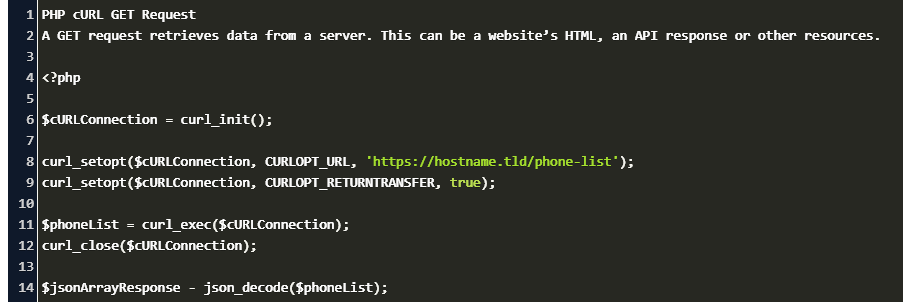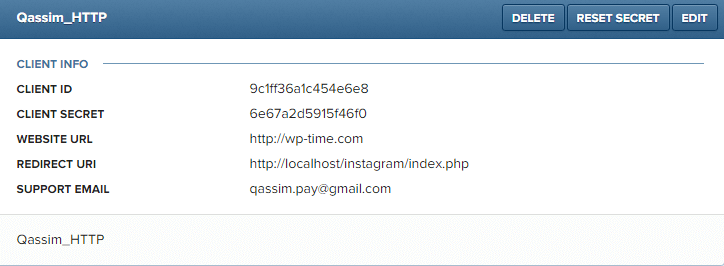The cURL is also used in command lines or scripts for data transfer. CURL with respect to PHP is a library that lets us make HTTP requests in PHP. It’s easier to do GET/POST requests with curlexec to receive responses from other servers for JSON format data response and to download files. PHP/cURL: The module for PHP that makes it possible for PHP programs to use libcurl. How to use it: step1: Initialize a curl session use curlinit. Step2: Set option for CURLOPTURL. This value is the URL which we are sending the request to.Append a search term 'curl' using parameter 'q='.Set option CURLOPTRETURNTRANSFER, true will tell curl.
Hello friends, Today we will learn about php CURL. CURL is used to make HTTP requests
cURL is a library that lets you make HTTP requests in PHP. Everything you need to know about it (and most other extensions) can be found in the PHP manual.
The cURL stands for ‘Client for URLs’, originally with URL spelled in uppercase to make it obvious that it deals with URLs. The cURL project has two products libcurl and curl.

- libcurl: A free and easy-to-use client-side URL transfer library, supporting FTP, TPS, HTTP, HTTPS, GOPHER, TELNET, DICT, FILE, and LDAP. libcurl supports TTPS certificates, HTTP POST, HTTP PUT, FTP uploading, kerberos, HTTP based upload, proxies, cookies, user & password authentication, file transfer resume, HTTP proxy tunneling and many more. libcurl is free, thread-safe, IPv6 compatible, feature rich, well supported and fast.
- curl: A command line tool for getting or sending files using URL syntax. Since curl uses libcurl, it supports a range of common internal protocols, currently including HTTP, HTTPS, FTP, FTPS, GOPHER, TELNET, DICT, and FILE.

What is PHP cURL?
The module for PHP that makes it possible for PHP programs to access curl functions within PHP. cURL support is enabled in PHP, the phpinfo() function will display in its output. You are requested to check it before writing your first simple programme in PHP.
Powerbook g4 latest os. Simple Uses: The simplest and most common request/operation made using HTTP is to get a URL. The URL itself can refer to a webpage, an image or a file. The client issues a GET request to the server and receives the document it asked for.
Some basic cURL functions:
- The curl_init() function will initialize a new session and return a cURL handle.
- curl_exec($ch) function should be called after initialize a cURL session and all the options for the session are set. Its purpose is simply to execute the predefined CURL session (given by ch).
- curl_setopt($ch, option, value) set an option for a cURL session identified by the ch parameter. Option specifies which option is to set, and value specifies the value for the given option.
- curl_setopt($ch, CURLOPT_RETURNTRANSFER, 1) return page contents. If set 0 then no output will be returned.
- curl_setopt($ch, CURLOPT_URL, $url) pass URL as a parameter. This is your target server website address. This is the URL you want to get from the internet.
- curl_exec($ch) grab URL and pass it to the variable for showing output.
- curl_close($ch) close curl resource, and free up system resources.Hello friends, Today we will learn about php CURL. CURL is used to make HTTP requestsThe curl_init() function will initialize a new session and return a cURL handle.
- curl_exec($ch) function should be called after initialize a cURL session and all the options for the session are set. Its purpose is simply to execute the predefined CURL session (given by ch).
- curl_setopt($ch, option, value) set an option for a cURL session identified by the ch parameter. Option specifies which option is to set, and value specifies the value for the given option.
- curl_setopt($ch, CURLOPT_RETURNTRANSFER, 1) return page contents. If set 0 then no output will be returned.
- curl_setopt($ch, CURLOPT_URL, $url) pass URL as a parameter. This is your target server website address. This is the URL you want to get from the internet.
- curl_exec($ch) grab URL and pass it to the variable for showing output.
- curl_close($ch) close curl resource, and free up system resources.
Get Request Example
Output:
Post Request Example
Php Curl Get Request
Recommended Posts:
In PHP CURL POST tutorial, I have explained how to send HTTP GET / POST requests with PHP CURL library.
Below are the examples covered in this article.
1) Send HTTP GET Request with CURL
2) Send HTTP POST Requests with CURL
3) Send Random User-Agent in the Requests
4) Handle redirects (HTTP 301,302)
5) Handle Errors.
Why we need PHP CURL ?
To send HTTP GET requests, simply we can use file_get_contents() method.
Php Curl Post Example

But sending POST request and handling errors are not easy with file_get_contents().
Sending HTTP requests is very simple with PHP CURL.You need to follow the four steps to send request.
step 1). Initialize CURL session
step 2). Provide options for the CURL session
Php Curl_init
CURLOPT_URL -> URL to fetch
CURLOPT_HEADER -> to include the header/not
CURLOPT_RETURNTRANSFER -> if it is set to true, data is returned as string instead of outputting it.
For full list of options, check this PHP Documentation.
step 3). Execute the CURL session
Php Curl Https
step 4). Close the session
Note: You can check whether CURL enabled/not with the following code.

1.PHP CURL GET Example
You can use the below code to send GET request.
2.PHP CURL POST Example
You can use the below code to submit form using PHP CURL.
How to use the function:
3.Send Random User-Agent in the Requests
You can use the below function to get Random User-Agent.
Using CURLOPT_USERAGENT, you can set User-Agent string.
4.Handle redirects (HTTP 301,302)
To handle URL redirects, set CURLOPT_FOLLOWLOCATION to TRUE.Maximum number of redirects can be controlled using CURLOPT_MAXREDIRS.
5.How to handle CURL errors
we can use curl_errno(),curl_error() methods, to get the last errors for the current session.
curl_error($ch) -> returns error as string
curl_errno($ch) -> returns error number
You can use the below code to handle errors.
For the full list of errors, refer CURL errors

